
- home
- Bandhani
- region
- raw material
- popular dyes for bandhani
- designs
- process of bandhani
- change in bandhani
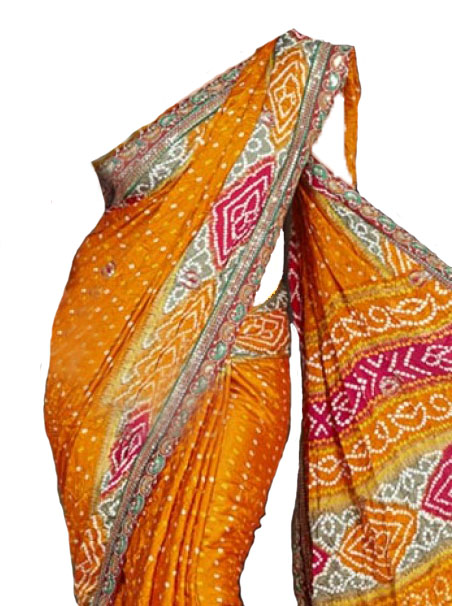 Bandhani Saree
Bandhani Saree
Dyed Textile- Process of Bandhani
Tying
 Though the process is simple but it is very time-consuming. The tying of the fabric is mostly carried out by women or young girls.
Though the process is simple but it is very time-consuming. The tying of the fabric is mostly carried out by women or young girls.
Tracing
The area of the fabric to be dyed is outlined using fugitive colors.  Then a clear thin sheet of plastic, which has been pierced with pin holes, is kept over this area of the fabric and using fugitive colours an imprint of the desired pattern is transferred onto the fabric..
Then a clear thin sheet of plastic, which has been pierced with pin holes, is kept over this area of the fabric and using fugitive colours an imprint of the desired pattern is transferred onto the fabric..
Knoting
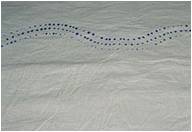 The craft person then pulls on a small area of the fabric where each hole is placed and winds thread tightly around the protruding cloth to form a knot or bhindi. The thread generally used is nylon thread.
The craft person then pulls on a small area of the fabric where each hole is placed and winds thread tightly around the protruding cloth to form a knot or bhindi. The thread generally used is nylon thread.
Washing
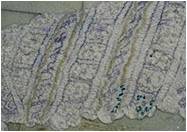 After tying the knots the fabric is thoroughly washed to remove the imprint
After tying the knots the fabric is thoroughly washed to remove the imprint
Dying
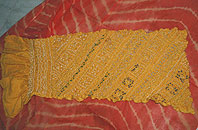 The cloth is then dipped in napthol for five minutes and dyed in yellow or another light color for two minutes. Next it is rinsed, squeezed, dried and then tied again and dipped in a darker color. This is kept for three to four hours (without opening the knots) to allow the color to soak in.
The cloth is then dipped in napthol for five minutes and dyed in yellow or another light color for two minutes. Next it is rinsed, squeezed, dried and then tied again and dipped in a darker color. This is kept for three to four hours (without opening the knots) to allow the color to soak in.
Finishing
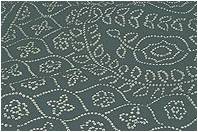 During this process the small area beneath the thread resists the dye leaving an undyed dot. This is usually carried out in several stages starting with a light color like yellow, then after tying some more knots a darker color is used and so on.
During this process the small area beneath the thread resists the dye leaving an undyed dot. This is usually carried out in several stages starting with a light color like yellow, then after tying some more knots a darker color is used and so on.
After the last dyeing process has been completed the fabric is washed and if necessary, starched. After the fabric is dried, its folds are pulled apart in a particular way releasing the knots and revealing their pattern. The result is a deep colored cloth with dots of various colors forming a pattern.